World of Warcraft: The Burning Crusade Hardware Performance Guide
Getting sluggish performance in World of Warcraft? Check out our Burning Crusade hardware performance guide to find out what components to upgrade.
- Posted on Thursday, January 18, 2006.
World of Warcraft wasn't a performance monster when Blizzard first released the game in late 2004. Players with modest and even mediocre systems could all get passable frame rates in Azeroth. Blizzard has stated that World of Warcraft will eventually get graphical improvements to keep the game up to date, but those changes aren't coming in the game's first expansion pack, World of Warcraft: The Burning Crusade. With 8 million subscribers and growing, you don't need to push out advanced graphics and raise hardware requirements just yet.
We revisited World of Warcraft in this new hardware performance guide since many of you will be returning to the game for the opening of the dark portal, or using the expansion as an excuse to upgrade your PC systems. Several generations of video cards have passed since World of Warcraft's initial release. The GeForce 6 series has long been replaced by the GeForce 7 series, and the 8 series is already here. Entry-level video cards have improved in the past two years. The industry's rapid pace of innovation means that you can buy a lot more processing power today for the same amount of money. The game doesn't require the best hardware to run well, but you will get better performance from the latest technology.
It's difficult to create a reproducible benchmark in an MMO with a persistent world. You could spawn your own dungeon instance or find an empty spot hidden away from player traffic, but we wanted to include that foot traffic since it's a major part of the gameplay experience. We decided to use the first 60 seconds of the gryphon flight from The Stair of Destiny to Honor Hold in the Hellfire Peninsula as our benchmark. It's the first flight path you encounter in the new Outland area, and the path is the same every time you take it. One significant variable out of our control is the number of players and monsters we fly over on the path. Frame rates varied at the low-resolution settings but became fairly stable at higher resolution levels such as 1600x1200 and 2048x1536.
Game Settings
You can easily run the game with all the settings enabled on most midrange hardware, but you can disable a few settings to get more performance from less powerful systems.
Graphics
Upgrading your video card will get you higher frame rates and higher resolutions, but you can still get decent performance out of older hardware. We tested the Burning Crusade on 14 different video cards.
CPU
The Burning Legion is very CPU friendly. You'll be able to play just fine on a two- or three-year-old CPU, but getting a better processor can still improve your frame rates.
Memory
World of Warcraft still loves memory. If you're only going to get one upgrade for Burning Crusade, make it an extra 1GB of RAM.
Settings
World of Warcraft: The Burning Crusade looks good. It may not have all the advanced graphics effects, but it still looks great thanks to stunning artwork and a consistent design theme. You should be able to max out all of the settings without too much trouble on most midrange systems. We broke out an older card, a GeForce 6600 GT, to see how much each setting affected performance.
Draw distance reduced performance the most, shaving almost 30 percent off of the system's average frame rate. Disabling the shader settings will also garner you several frames at the expense of image quality. If you really want to reclaim some performance, you'll have to do it the old-fashioned way, by going easy on the resolution and antialiasing settings.
System Setup: Intel Core 2 X6800, Intel 975XBX2, 2GB Corsair XMS Memory (1GB x 2), 160GB Seagate 7200.7 SATA Hard Disk Drive, Windows XP Professional SP2. Graphics Cards: GeForce 6600 GT, Nvidia Forceware 93.71.
Image Setting Comparisons
Move your mouse over the default image to see the comparison image.
Terrain Distance Max. vs. Terrain Distance Min.
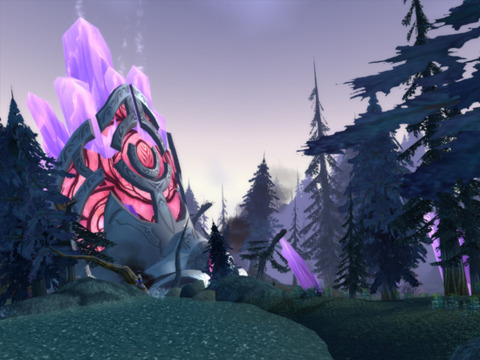
Shaders: Full Screen Glow Enabled vs. Full Screen Glow Disabled
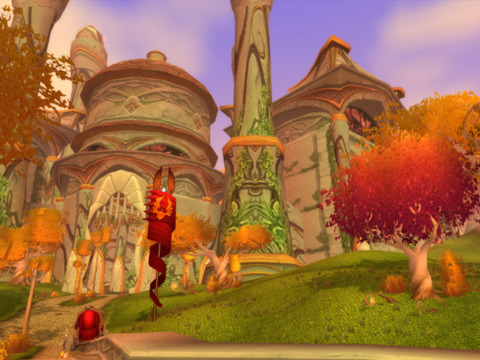
Environmental Detail Max. vs. Environmental Detail Min.

More Image Setting Comparisons
Move your mouse over the default image to see the comparison image.
Shaders: Terrain Highlights Enabled vs. Terrain Highlights Disabled
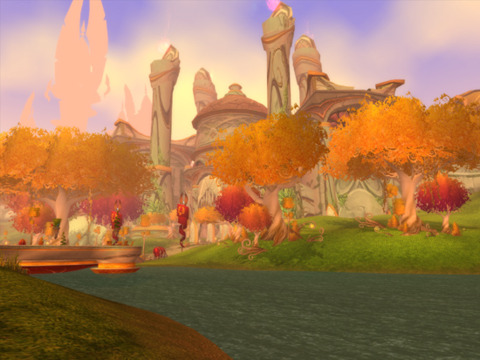
Terrain Texture Detail Max. vs. Terrain Texture Detail Min.
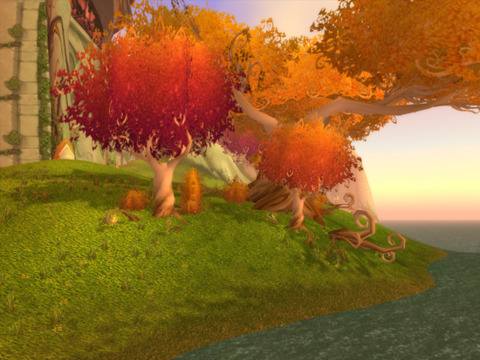
Weather Intensity Max. vs. Weather Intensity Min.
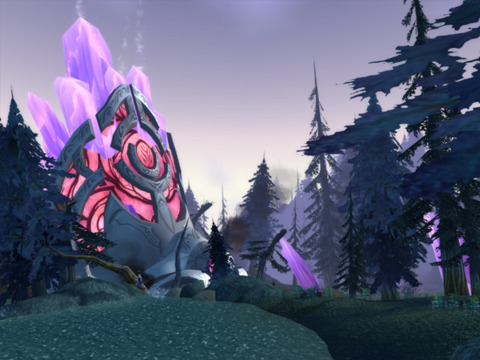
Graphics
Burning Crusade likes bigger and faster video cards, but you might not need to upgrade to fully enjoy the game. If you're willing to play at lower resolutions, you can get away with using less expensive parts with no trouble at all. The only video cards that really gave us trouble were the older, budget-range cards, such as the GeForce 6200 or the Radeon X300 SE.
System Setup: Intel Core 2 X6800, Intel 975XBX2, 2GB Corsair XMS Memory (1GB x 2), 160GB Seagate 7200.7 SATA Hard Disk Drive, Windows XP Professional SP2. Graphics Cards: GeForce 8800 GTX 768MB, GeForce 7900 GTX 512MB, GeForce 7900 GT 256MB, GeForce 7600 GT 256MB, GeForce 7900 GS 256MB, GeForce 6600GT 128MB, GeForce 6200 TC 128MB, Radeon X1950 XTX 512MB, Radeon X1900 XTX 512MB, Radeon X1950 Pro 256MB, Radeon X1900 XT 256MB, Radeon X1650 Pro 256MB, Radeon X1300 XT 256MB, Radeon X300 SE 128MB. Graphics Drivers: Nvidia ForceWare 97.92, Nvidia ForceWare 93.71, ATI Catalyst 7.1.
Memory
Burning Crusade isn't a huge resource hog, but you'll definitely want more than 512MB of RAM. Our test system stuttered heavily while loading populated areas with only 512MB of system memory. All of our problems disappeared once we increased system memory to 1GB. Upgrading to 2GB of RAM might not be necessary, but consider it if you plan on upgrading to Windows Vista--Microsoft's new OS has a huge memory footprint.
System Setup: Intel Core 2 X6800, Intel 975XBX2, 2GB Corsair XMS Memory (1GB x 2), Corsair XMS Memory 1GB, Corsair XMS Memory 512MB, 160GB Seagate 7200.7 SATA Hard Disk Drive, Windows XP Professional SP2. Graphics Card: GeForce 8800 GTX 768MB, Nvidia ForceWare 97.92.
CPU
If you have a good video card, you'll need to couple it with a powerful CPU to get the best frame rates possible. Burning Crusade scales very well with processor power, but quad-core didn't seem to do much for us in our tests. You'll be fine playing the game with a fast single or dual-core CPU.System Setup: Intel Core 2 Quad X6700, Intel Core 2 X6800, Intel Core 2 Duo 6300, Intel 975XBX2, AMD Athlon 64 FX-60, AMD Athlon 64 FX-57, AMD Athlon 64 4000+, ASUS A8R32-MVP Deluxe, 2GB Corsair XMS Memory (1GB x 2), 160GB Seagate 7200.7 SATA Hard Disk Drive, Windows XP Professional SP2. Graphics Card: GeForce 7900 GTX, Nvidia ForceWare 93.71
Got a news tip or want to contact us directly? Email news@gamespot.com
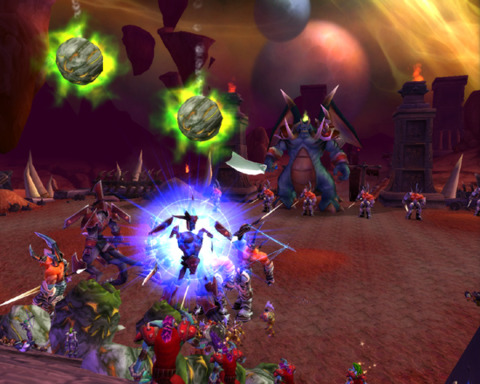
Join the conversation